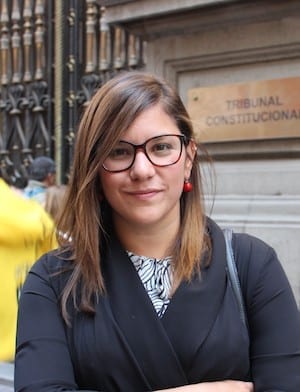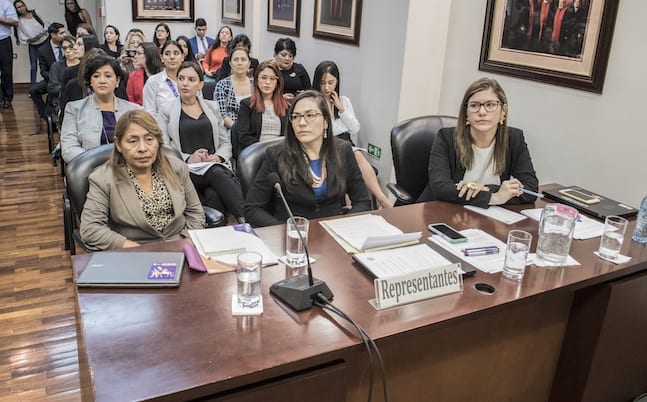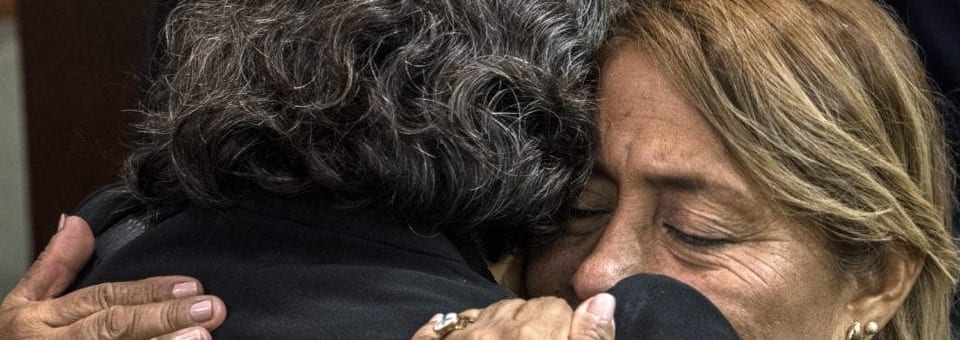Catalina Martínez Coral on the Center’s Recent Human Rights Victory in Latin America
Ruling from Inter-American Court of Human Rights Will Help Protect Schoolgirls from Sexual Violence
As a global organization, the Center for Reproductive Rights advances reproductive rights as human rights around the world. In August, the Center secured a landmark victory in a case at the Inter-American Court of Human Rights that established standards to protect girls from sexual violence and harassment in schools throughout Latin America and the Caribbean, and held Ecuador responsible for failing to protect an adolescent public-school student from sexual abuse at her school.
Catalina Martínez Coral, the Center’s regional director for Latin America and the Caribbean, headed the Center’s litigation efforts in the case, Paola Guzmán Albarracín v. Ecuador.

Martínez Coral brought invaluable experience to litigating the case. Before joining the Center in 2015, she worked as a human rights specialist at the Inter-American Commission on Human Rights, which together with the Inter-American Court of Human Rights is entrusted by the Organization of American States with promoting and protecting human rights. Martínez Coral also worked as a field legal officer at the United Nations Development Programme in Montes de María, Colombia, in the program on peace and reconciliation.
In this discussion, Martínez Coral talks about the case and its impact on the country, the region, Paola’s family—and Martínez Coral herself.
Q. Can you briefly describe the case?
A. Paola Guzmán Albarracín was an Ecuadorian teenager who was repeatedly sexually abused by her school’s vice-principal. Because of this abuse, Paola attempted suicide one day by ingesting poison before heading to school. But instead of getting her immediate medical help, the school asked her to pray for her soul. After several hours, her classmates were finally permitted to contact Paola’s mother, who took her to the hospital. Tragically, Paola, who was 16, died at the hospital. That was in December 2002.
For a long time Paola’s family members were denied justice through traditional legal channels in Ecuador—but they refused to give up. They not only sought accountability for her abuse and her death—they also fought to clear Paola’s reputation: Because of pervasive gender stereotypes in Ecuador, Paola was accused of provoking her aggressor and was blamed for her abuse by her school, her community and the media. So Paola’s family had to deal with not only her terrible death, but also the outrageous attacks against her.
Q. Why did it take 18 years to get justice for Paola?
A. First, because Ecuador’s justice system did not handle the case properly from the time Paola took her life in 2002. So, in 2006, because of the State’s ineffectiveness, the Center and its regional partner, the Ecuadorian Center for the Promotion and Action of Women (CEPAM-Guayaquil), decided to present the case before the Inter-American Commission on Human Rights (IACHR). The IACHR admitted the case in 2008.
Between 2010 and 2014 there were negotiations with Ecuador to reach a settlement, but ultimately these negotiations were not fruitful due to the lack of commitment from the government. So the IACHR continued its analysis and in 2018 decided that Ecuador was responsible for the human rights violations alleged in the case.
In 2019, the IACHR sent the case to the Inter-American Court of Human Rights, which heard arguments in January 2020 and issued its ruling in August.
The far-reaching ruling held Ecuador responsible for failing to protect Paola at school. But it went far beyond that, establishing legally binding standards to prevent sexual violence and harassment in schools throughout the entire Latin America and Caribbean region.
Q. How did the Center’s partnership with CEPAM-Guayaquil, your local partner in Ecuador, work?
A. This case was an excellent example of how the Center partners with local organizations to further its work in countries around the world. Establishing partnerships allows us to create joint workplans where the Center brings its legal experience at the international and regional level while our partners lead the national work. Our partners’ experience and on-the-ground knowledge are very important in developing strategies for advocacy and implementation that will complement the litigation work.
In this case, one of CEPAM-Guayaquil’s lawyers had an internship at the Center in New York—and that one relationship brought us together on this case. Both our organizations had been litigating it from the beginning, so we decided to join forces.
We have learned a lot from all their experience working in the field of sexual and reproductive rights in Ecuador. Their team, led by attorney Lita Martínez Alvarado, has been a strategic ally in obtaining this unprecedented result in the Inter-American Human Rights System. We have created a true and valuable partnership.

Catalina Martínez Coral (4th from left) and Doña Petita (4th from right) with the full legal team at the Inter-American Court of Human Rights
Q. Was Paola’s family compensated for Paola’s death?
A. Yes, Ecuador must make full reparations to Paola’s mother, Doña Petita, and her sister, Denisse, so that they can rebuild their lives with dignity after 18 years of impunity. The reparations have an economic compensation component for the damages they suffered. But perhaps most important are the symbolic reparations, an aspect of restorative justice that is fundamental for the victims.
For example, Ecuador will have to recognize its responsibility and make a public apology to Paola’s family. This should restore Paola’s good name and recognize that she was a victim of sexual violence and that her death was directly related to that sexual assault she endured.
To help girls in schools going forward, Ecuador must also declare, in honor of Paola, an official day for the fight against sexual violence in classrooms. And Paola’s mother is to receive Paola’s posthumous graduation diploma.
More broadly, as part of integral reparations, Ecuador is responsible for adopting public policies that will prevent sexual violence in schools, including a policy to provide access to sex education.
Q. What’s the significance of the decision by the Inter-American Court of Human Rights?
A. The Court’s decision has a broad impact in Latin America and the Caribbean. It establishes that the right to comprehensive education includes access to sexual and reproductive education adapted to the age and needs of girls and adolescents, so that they understand their sexual and reproductive rights and the implications of emotional relationships. States will no longer be able to ban sexual and reproductive education, since it has been established as a human right.
The ruling also recognizes that adolescents and girls have freedoms, among which are sexual freedom and the freedom of self-control of their own bodies, both of which can be exercised according to their evolving capacity and maturity.
Also, the Court made it clear that victims of sexual violence should not be blamed as having provoked the aggressors, as was said unjustly about Paola. The Court noted that these types of false and misleading accusations are the product of gender stereotypes that have normalized sexual violence, so that the community and society see and treat sexual abuse and harassment as normal behavior.

L-R: Doña Petita with the Center’s Alejandra Cárdenas and Catalina Martínez Coral at the Inter-American Court of Human Rights
Q. How wide is the ruling’s reach?
A. The ruling applies directly to 25 countries that have accepted the jurisdiction of the Inter-American Court of Human Rights. And it goes further: The human rights standards created in this judgment also have become part of the whole Inter-American System of Human Rights, which is recognized by more than 25 countries in Latin America and the Caribbean.
So this decision could impact millions of people going forward—and this is a tremendous step forward in the Center’s fight for the human rights of women and girls.
Q. The decision allows a year for implementation. What are those plans?
A. Ecuador’s government has stated that it will comply with the ruling. With our partners at CEPAM-Guayaquil we have already initiated conversations with the executive branch to reach an initial agreement on steps for implementation. The first step is the reparations for Paola’s family members, including organizing the symbolic events to clear Paola’s name.
The next step will be to implement the new standards—in Ecuador, then in the entire region. Toward this goal, the Center will be working with the government in Ecuador and other civil society organizations to define the components of a policy to prevent sexual violence in schools, with an emphasis on sex education.
Q. How will the ruling be enforced in each country?
A. The answer is different with regards to Ecuador and to other countries. Ecuador is bound under international law and its constitution to comply with the judgment, and the Ecuadorian government has shown a very important political will towards fully complying. It’s expected that by December 2020, most of the reparations ordered in the judgment will be fully complied with. The requirement that Ecuador take measures to assure that girls have access to sex education is expected to take a bit longer, since it involves the development and implementation of public policies.
Concerning the rest of the region, the Court’s judgment establishes standards that have direct enforceability within each of the States that are parties to the American Convention on Human Rights. These States should take steps to adapt their legislation and policies to the standards. Failing to do so could lead to legitimate claims before national and international tribunals.
In fact, there is a universe of possibilities for enforcement. If governments and legislatures fail to comply, each country’s judiciary should require compliance at the national level. If there is further non-compliance, a new case could be submitted either to the Inter-American System or to the United Nations Human Rights systems.
Q. What do you expect the real-life, day-to-day impact to be? On students? On schools and administrators?
A. We hope that through the implementation of the Court’s decision, appropriate and sufficient sexual and reproductive education will become part of the daily life of schools in the region. Only by giving all students this type of education can the structural problem of sexual violence against girls and adolescents be resolved. Sexuality education will be a means through which gender prejudices can be eliminated and the community can more easily identify and denounce these abuses. This is the only way to change daily life in the classrooms of the region.
Q. Do you expect this will change cultural norms?
A. We do expect this ruling to change cultural norms regarding gender stereotypes that have normalized sexual violence, which in turn has made it difficult for people to identify these behaviors as such. In fact, the judgment says that Ecuador must take measures to promote “the empowerment of girls towards challenging patriarchal norms and stereotypes,” thus preventing or reversing all kinds of discrimination.
Q. What inspired your legal team?
A. [Paola’s mother] Doña Petita’s unrelenting fight for justice has always motivated us to do the best possible work for her and for Paola’s memory.
Q. How did Paola’s family persevere for so long?
A. Throughout all these years the greatest fighter was Doña Petita. Since her daughter died, she dedicated herself in a courageous and persistent manner to seek justice. She never gave up; she became an activist, not only because she wanted justice for the crime perpetrated against her daughter, but also because she did not want the same thing to happen to other girls.
We must also recognize the courage of Paola’s sister Denisse, who had to grow up amid this fight for justice.
Q. Can you share with us Paola’s family’s reaction to the Court’s decision?
A. Doña Petita and Denisse received this news calmly—with peace of mind and emotion. While the ruling won’t bring Paola back, they know that at last Paola’s good name would be restored, that it would be clear that she had been a victim of sexual abuse. With the strength that characterizes her, Doña Petita also agreed to talk to the media interested in Paola’s story and the Court’s decision so that people would know about what happened—and that no girl would have to go through the same thing.
Q. On a personal level, what have you learned from working on this case, and what does it mean to you?
A. It has been life-changing for me. It was the first case I worked on when I joined the Center in 2015. It has been a privilege for me to be able to continue the work of so many attorneys—from both CEPAM-Guayaquil and the Center, since the case started 14 years ago, before I joined. It has also been an honor to work on the preparation and litigation of the case with my colleagues and partners.
Overall, it was certainly a collective work that taught us many lessons. Maybe the most important one is about the value of teamwork: Each member of our team was essential to litigating this case.
I am also very satisfied with the results of the decision on a more structural level and hope that with the standards that were created and their implementation we will have contributed to creating adequate mechanisms for the prevention of and attention to sexual violence, the elimination of stereotypes, and the importance of sexual and reproductive rights education to guarantee girls’ and women’s control over their lives.
Finally, most importantly, being able to walk alongside Doña Petita and Denisse in this last stage of the litigation has been very emotional for me. I am so grateful for all the things they have taught me and all the strength they have given me. This fight was for them, to support them in their path to justice, and I hope they have more peace today in their hearts.
More on Paola’s case:
Feature Story: “Landmark Ruling Will Help Protect Schoolgirls from Sexual Violence Throughout Latin America”
Video: Martínez Coral argues Paola’s case before the Inter-American Court of Human Rights, January 28, 2020 (in Spanish)
More news on the Center’s Work in Latin America and the Caribbean

